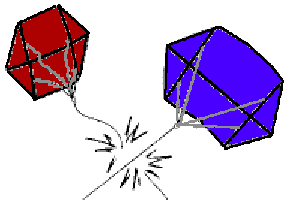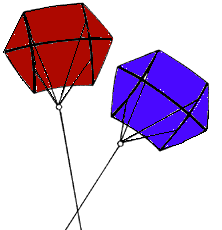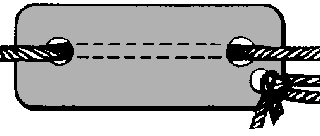Rokkaku Flying and Fighting
From the book The Fighter Kite Book!
by David Gomberg
What is a Rokkaku?
The Rokkaku (pronounced roke-cock-coo) is a traditional
Japanese bowed kite design. A basic hexagon in shape, it features six corners, a
long center spine, and two cross spars. The bridle connects at four or more
points.
Combat Fundementals
Western style Rokkaku "battles" are usually organized
for either individuals or teams. The size of the kites is specified within
certain ranges, only certain types of flying line are allowed, and flying is
limited to a designated area for safety.
On a given signal, all kites are launched. Then a second
signal is given and the kites "engage".
The object is to ground other kites using either your
line, your kite, or the wind. Once your kite is cut or touches the ground for
any reason, you are out. There are three basic techniques for grounding an
opponent's kite. The most effective strategy may combine all three tactics.

| Cutting: Any experienced kite flier knows
that flying lines can easily slice through each other given the proper
circumstances. In a Rok battle, it's your job to create those
circumstances.
When two lines come in contact, the one moving the
fastest will cut, melt, or burn through the other. The object is to
concentrate the friction in one particular point on an opposing line.
Often you will see teams methodically pumping in an effort to saw through
an opponent's line. |
|
Tipping: Another effective battle technique
involves actually contacting an opposing kite with your flying line. By
catching one of the kite's six corners and then quickly moving position,
you are often able to tip or up-end an opponent. If they are close to the
ground, in poor field position, or just not particularly good at
recovering, this may put them out of the fight. Tipping is the easiest and
safest way to ground someone. |

|
Wind Blocking: A more sophisticated technique
involves using the wind -- or lack of it -- to ground an opponent. Battles are
not always fought under ideal circumstances. If the wind is light, simply
staying airborne may be enough to win as everyone else backs up to the field
boundaries in an effort generate lift. They will run out of space and come down.
If you're smart, you won't.
Battle Strategy: Positioning is everything in a
battle. That includes positioning to take full advantage of strong or light
winds, positioning to attack or retreat, and positioning to avoid major tangles.
Before you launch at the beginning of the battle, give some thought to the wind
conditions.
|
If winds are light, you may want to stay as
far downwind as possible so you have room to back-up and gain altitude.
You may also want to use a long line to get as much height during the
launch as possible and be able to reel-in later to maintain altitude.
If winds are heavy, you may want to
position yourself upwind so you have room to move forward and drop into
the fight. You may also want to use a shorter line so you can reel-out to
make contact. |

Be alert, mobile, and
aggressive. |
Try to avoid multi-kite engagements that increase your
risk of getting tangled or boxed in. Your chances of cutting or fighting your
way out of that kind of a mess are rare. What's more likely is that someone will
wrap a line around your bridles and you will all go down together.
Don't hang back in a corner waiting for someone else to
clear the skies, either. You don't win battles or the respect of your opponents
by running away. Look for opportunities and then attack! Besides, most contests
will eventually disqualify contestants that continue to avoid direct combat.
Finally, don't let an opponent's line contact your kite.
Maintain the initiative. The best position to be in is to be on the attack, not
on the defensive.
|
Rokkaku Tuning
A number of factors can be adjusted to affect your
flying and maneuverability. The stiffness of your spars and spine, the
proportions of the kite, the length of the bridle, position of the
tow-point, and the amount of bow in either or both of your spars will help
or hamper maneuverability in different winds. |

A "Slider" maintains bow in
Bridle |
The two quickest and easiest adjustments you can make in the field are to
change the amount of bow in the kite, or to shift the tow-point. Experiment!
Safety, Safety, Safety!
Battles are great fun - but only if they are done
carefully and everyone follows basic safety rules. Gloves are essential for all
participants. These are big kites being flown on line intended to cut. Imagine
what they can do to your hands. The object is to make the kites fight - not the
people. All intentional physical contact should be strictly prohibited including
pushing, tripping, or purposely running line around people. Any "dirty tricks"
should result in disqualification. Cutting implements other than flying line
should not be allowed.
As much fun as Rokkaku battles are to watch, they are
even more fun to participate in. So we'll warn you this one time: You only need
to try it once to become addicted for life.
| FeiLong Kite M.P. : 18363688061 Email: wfkite@163.com |


